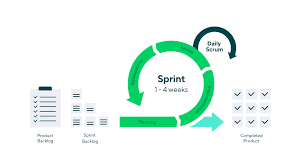ITIL vs Scrum
ITIL and Scrum are two core concepts in the current world of agile software development and IT operations. You might be unsure of the difference between them, or how they interrelate. This article will clear all of that up, so you can probably understand the nature of the ITIL vs Scrum debate. Let’s get into it.
What is ITIL?
ITIL stands for IT (Information Technology) Information Library. It is a collection of practices around ITSM (IT service management). It is quite old, being created in the UK in the 1980s. However it has gone on to become a standard for IT operations and service management.
ITIL has gone through a few iterations. The earliest version was released in 1989 by the CCTA (Central Computing and Telecommunications Agency). There was a version 2 in 2001, and a version 3 in 2007. It went through a minor update in 2011.
The latest ITIL is version 4, which came out in 2019. This was a major update, that moved away from the “service lifecycle” model of previous versions, and instead proposed a “Service Value System”, with five components:
- Guiding principles
- Governance
- Service value chain
- Continual improvement
- Practices.
There are over 30 of these practices, covering everything from strategy management to change enablement and software development. Adding software development was an unusual move, since ITIL had traditionally been more about service management and operations.
There is very little ITIL has to say on software development, however. Since that is not its specialization. ITIL is more about service management, i.e. Operations, not software development.
And what about Scrum?
Scrum is quite different to ITIL. They are operating in quite different domains.
Scrum is a framework for agile software development. So it was created as a way for people to put the ideas of the agile manifesto into action. And get software delivered in an agile way.
It is based around three roles (Product Owner, Scrum Master, Developer), who work together in a cross-functional team. They plan and delivery work in short iterations, called “sprints” (which are usually two weeks long).
The team pulls work from a Product Backlog, into a sprint. This is called the “Sprint Backlog”. The Product Backlog is very flexible (the Product Owner can change it whenever they want), but the Sprint Backlog is more locked down.
At the end of a sprint, the team shows their work to stakeholders in a Sprint Review. Then, they discuss amongst themselves how they have worked and how they can improve. These events enable transparency and continuous improvement. Which are very core parts of agile software development.
ITIL vs Scrum
So it is pretty clear. ITIL and Scrum are quite different concepts. ITIL is much more focused on the Operations or Service Management side of IT. Keeping systems up and running, monitoring them, managing changes to them, and so on. Scrum is a framework for software development. It helps teams build a new software product in an agile and iterative way.
Scrum doesn’t talk much about actual software releases. It says teams should try and get a “potentially shippable product increment” ready every sprint. But what does shippable really mean? Who ships it? When? How? With what controls or approvals? Who fixes if it goes wrong?
Scrum doesn’t really have any answers to those questions. That’s not a big flaw, it’s just a different domain. Scrum tells you how to build software. It doesn’t say much about the production / operations side of things. ITIL is the other way around.
Although ITIL v4 has added a principle around software development, it has very little to say on that matter. If you are interested in software development, especially agile, Scrum will be of more interest to you.
ITIL talks a little bit about Waterfall vs agile, and the differences and pros or cons between the two. But if you want to properly learn a framework for agile software development (or Waterfall for that matter!), then ITIL won’t
If you are interested in the operations side of things, ITIL could be right for you. Although I feel that ITIL is a bit of a dinosaur. Many people in IT these days are moving towards DevOps.
While DevOps isn’t really the opposite of ITIL, it is quite a different approach. It focuses more on collaboration, ways of working, and automation. While ITIL is more focused on process, control, planning and governance.
ITIL training and certifications won’t hurt, that’s for sure. Unlike ITIL, DevOps doesn’t really have a central governing authority, or universally recognized certifications.
There are courses and certificates out there for DevOps, but “buyer beware” applies.
ITIL vs Scrum certifications
You can of course get both an ITIL certification or a Scrum certification.
I have written a lot about getting scrum certified here. If you want to know about ITIL certifications, you can read more about them at the Axelos website.
Summary
In summary, ITIL and Scrum are quite different things, looking at different domains. Scrum is more focused on software development (in accordance with agile principles and values), while ITIL is more about operations and service management. Each is important and valuable.



